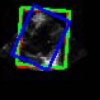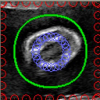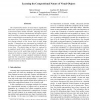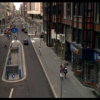CVPR
2007
IEEE
16 years 2 months ago
2007
IEEE
109
click to vote
CVPR
2007
IEEE
16 years 2 months ago
2007
IEEE
The state-of-the-art object detection algorithm learns a binary classifier to differentiate the foreground object from the background. Since the detection algorithm exhaustively s...
106
click to vote
CVPR
2007
IEEE
16 years 2 months ago
2007
IEEE
Current approaches to motion category recognition typically focus on either full spatiotemporal volume analysis (holistic approach) or analysis of the content of spatiotemporal in...
114
click to vote
CVPR
2007
IEEE
16 years 2 months ago
2007
IEEE
In this paper we derive differential equations for evolving radial basis functions (RBFs) to solve segmentation problems. The differential equations result from applying variation...
110
click to vote
CVPR
2007
IEEE
16 years 2 months ago
2007
IEEE
The compositional nature of visual objects significantly limits their representation complexity and renders learning of structured object models tractable. Adopting this modeling ...
CVPR
2007
IEEE
16 years 2 months ago
2007
IEEE
In this paper we present two contributions to improve accuracy and speed of an image search system based on bag-of-features: a contextual dissimilarity measure (CDM) and an effici...
113
click to vote
CVPR
2007
IEEE
16 years 2 months ago
2007
IEEE
In visual 3-D reconstruction tasks with mobile cameras, one wishes to move the cameras so that they provide the views that lead to the best reconstruction result. When the camera ...
CVPR
2007
IEEE
16 years 2 months ago
2007
IEEE
The proliferation of low-cost infrared cameras gives us a new angle for attacking many unsolved vision problems by leveraging a larger range of the electromagnetic spectrum. A fir...
113
click to vote
CVPR
2007
IEEE
16 years 2 months ago
2007
IEEE
In this study we propose an integrated approach to the problem of 3D pose estimation. The main difference to the majority of known methods is the usage of complementary image info...
CVPR
2007
IEEE
16 years 2 months ago
2007
IEEE
We propose using stereo matching for 2-D face recognition across pose. We match one 2-D query image to one 2-D gallery image without performing 3-D reconstruction. Then the cost o...





